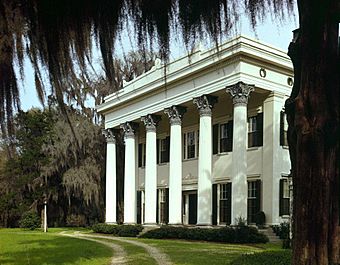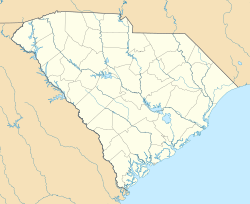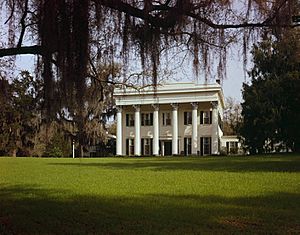Millford Plantation facts for kids
|
Millford Plantation
|
|

Millford Plantation as photographed by the Historic American Buildings Survey
|
|
| Location | On SC 261 west of Pinewood, South Carolina |
|---|---|
| Area | 712 acres (2.88 km2) surrounding house (out of 4,251 acres (17.20 km2) total) |
| Built | Completed in 1841 |
| Built by | Nathaniel F. Potter of Providence, Rhode Island |
| Architectural style | Greek Revival |
| NRHP reference No. | 71000808 |
Quick facts for kids Significant dates |
|
| Added to NRHP | November 19, 1971 |
| Designated NHL | November 7, 1973 |
Millford Plantation (sometimes called Milford) is a very old and important house and farm in South Carolina. It is located near Pinewood. This grand home was built using money earned from the forced labor of enslaved people. Because it was built in a faraway place and had so many fancy details, people sometimes called it Manning's Folly. Millford Plantation is known as one of the best examples of Greek Revival style homes in the United States. Today, the house has been carefully fixed up and kept safe, along with many of its original furniture pieces.
History of Millford Plantation
Building the Grand Mansion
The large, two-story Millford Plantation house was built between 1839 and 1841. It was made for John L. Manning and his wife, Susan Frances Hampton Manning. John Manning was a very wealthy man who forced 670 people of African descent to work for him. He later became the Governor of South Carolina from 1852 to 1854.
The person who built the house was Nathaniel F. Potter from Providence, Rhode Island. He might have also designed the building.
The front of the house is very impressive. It has six huge Corinthian columns that stand on granite bases. These columns hold up the front porch, called a portico. The walls of the house are 2-foot-thick (0.61 m) and made of bricks. These bricks were made right there on the property. The granite for the columns was brought all the way from Rhode Island.
The amazing design of Millford continues inside the house. There are tall windows that reach from the floor to the ceiling. There is also a spectacular round staircase that seems to float without support. This staircase is inside a round room with a domed ceiling at the back of the house.
The Manning Family and Their Wealth
Susan Frances Hampton was the daughter of General Wade Hampton I. He was one of the largest slave owners in the United States. Susan inherited a lot of money from her father. Much of the $125,000 used to build the Millford mansion likely came from her inheritance. This was a huge amount of money in 1840.
Sadly, Susan Hampton Manning died in 1845 while giving birth to her third child. In 1848, John Manning married Sally Bland Clarke and they had four children together.
Saving Millford During the Civil War
Near the end of the Civil War, the house was almost destroyed. On April 19, 1865, Union troops were going to burn it down. However, their commander, Brigadier General Edward E. Potter, stepped in and saved it.
General Potter and Governor Manning had a famous conversation:
- Potter: "This is a fine structure."
- Manning: "Well, the house was built by a Potter (Nathaniel Potter, the architect) and it looks as though it will be destroyed by a Potter."
- Potter: "No, you are protected. Nathaniel Potter was my brother."
General Potter did not know that Governor Manning had a copy of the Articles of Secession in his desk. This document was very important in starting the Civil War. If General Potter had known, the story of Millford's survival might have been very different.
Later Owners and Preservation
Even after the Civil War caused economic problems, the Manning family kept Millford until 1902. Then, they sold it to Mary Clark Thompson from New York. When she passed away in 1923, she left it to her two nephews. The Clark family owned the house until 1992. They mostly used it as a winter getaway for hunting and fishing.
On November 19, 1971, Millford Plantation was added to the National Register of Historic Places. On November 7, 1973, it was named a National Historic Landmark. This means it is very important for its history and art.
In May 1992, Richard Hampton Jenrette bought the house and 400 acres of land. He was a founder of a New York investment banking company. He was also a distant relative of Susan Hampton Manning. He called the estate "the Taj Mahal of my dreams" because he loved it so much. He worked very hard to restore the house perfectly.
Jenrette received awards for his work on Millford in 1995 and 2006. In December 2008, he gave the mansion to the Classical American Homes Preservation Trust. This foundation works to "Preserve, protect and open to the public examples of classical American residential architecture, fine and decorative arts of the first half of the 19th century."
In 2012, a group called "Friends of Millford" was started. They are supporters who want to help preserve the site for future generations.
Duncan Phyfe Furniture Collection
Furnishing Millford
John and Susan Manning decorated Millford in the popular Grecian style of their time. They bought a lot of furniture from Duncan Phyfe, who was one of America's most famous furniture makers. Many of these original pieces are still in the house today. This furniture shows the style of Duncan Phyfe's work later in his career.
In 1840, John Laurence Manning visited New York City. He likely went to Phyfe's company, D. Phyfe & Son. Between 1840 and 1844, the Mannings placed four separate orders for a total of 72 furniture items. More than 50 of these pieces are still at Millford today.
Phyfe's Grecian Plain Style
During this time, Phyfe's furniture often used smooth, highly polished wood with little carving. It featured designs like volutes (spiral shapes), deep cavetto cornices (curved moldings), simple square columns, and special "Grecian scrolls." These scrolls were inspired by French furniture designs from the 1820s.
Every room in the mansion was filled with D. Phyfe & Son furniture. This is known from a letter and a list of items from the company in 1841. Most of the furniture was in the Grecian plain style. However, for the double parlor, the Phyfes created something new. They mixed the Grecian style with elements from Gothic and French styles. This was unusual because the Phyfes usually did not use these mixed historical styles.
Materials and Purpose
In the entrance hall, most of the furniture is made of walnut. This wood was a good choice because it was affordable and strong. But in the double parlors, the furniture is mostly made of rosewood. This was a very expensive and special wood from South America. Using luxury woods in the parlors showed that these rooms were for formal gatherings. They were a place for the Mannings to show off their good taste and wealth.
In the dining room, the oval table matches the shape of the room. It is made of mahogany and has four animal-paw feet and six leaves that can be added. Other pieces ordered for the dining room included 14 armchairs in the French Restoration style. It was uncommon to have armchairs at every seat at a dining table back then. Usually, armchairs were only at the head and foot of the table.
Bringing the Collection Back Together
When Richard Jenrette bought the property in 1992, less than half of the original furniture was still in the mansion. He spent many years researching and working with experts. He found and bought many of the original furniture pieces and brought them back to Millford. Other pieces were given by the families who had owned the plantation. This hard work is still ongoing, and more pieces are expected to return in the future.
Millford and its furniture are special because the entire house was decorated with furniture ordered from just one cabinetmaker. This was very uncommon at the time. It was also one of the largest orders Duncan Phyfe ever received. Most of these pieces are still in the same building they were made for, which makes Millford a truly unique place in the United States.
See also
- National Register of Historic Places listings in Sumter County, South Carolina
- List of National Historic Landmarks in South Carolina
- St. Mark's Episcopal Church (Pinewood, South Carolina), the parish church for Millford Plantation.
- Plantation complexes in the Southern United States




